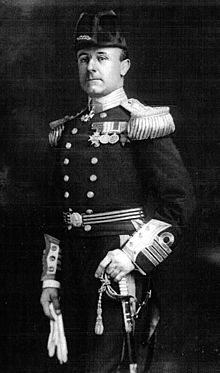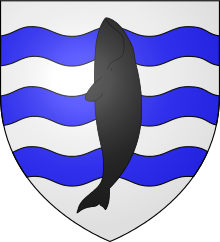John Jellicoe, 1st Earl Jellicoe
John Rushworth Jellicoe, 1st Earl Jellicoe , OM , GCB , GCVO , (born December 5, 1859 in Southampton , † November 20, 1935 in Kensington ) was an Admiral in the British Royal Navy and Governor General of New Zealand .
Life
Early years and training in the Navy
Jellicoe was born into a sailor family. In 1872 he joined the Royal Navy as a cadet , he was trained on the training ship HMS Britannia .
In September 1874 he was transferred to the ironclad HMS Agincourt with the rank of midshipman . His promotion to sub-lieutenant took place on December 5, 1878 on board HMS Alexandra , the flagship of the British fleet in the Mediterranean . He was promoted to lieutenant on September 23, 1880 , and returned to the ironclad HMS Agincourt .
First combat missions in Egypt and China
In February 1881, he commanded a landing operation of the Marines in Ismailia during the Egyptian war .
Jellicoe qualified as an artillery officer in 1883 and was transferred to the Gunnery School as a staff member . In 1885 he served on the HMS Monarch as an artillery officer and was awarded the Sea Gallantry Medal for rescuing crew members of a sunken steamer off Gibraltar .
In 1888 he was appointed to the Admiralty . In 1891 he was promoted to commander and was first officer (in English: executive officer = executive officer) of the HMS Victoria when this ship was rammed in an accident in the Mediterranean in 1893 and sank. He was not at fault. Between 1890 and 1900 Jellicoe had a large number of commands. On January 1, 1897, he was promoted to captain .
Around 1900 he served as a captain on the HMS Centurion and was chief of staff to Vice Admiral Edward Hobart Seymour . Jellicoe took part in the Allied attack on Beijing during the Boxer Rebellion in China ( Seymour Expedition ). On August 5, 1900, he was seriously wounded in the Battle of Beicang . After the battle he was awarded the Bath Order and the German Red Eagle Order, second class with crossed swords . In 1901 Jellicoe returned to the United Kingdom and was transferred to the Navy High Command. In August 1903 he commanded HMS Drake .
Navy High Command
Under First Sealord John Arbuthnot Fisher , Jellicoe was director of naval armaments (1905-1907) and then naval inspector (1908-1910). He campaigned heavily for funding to modernize the Navy, supporting new developments such as dreadnoughts and submarines .
In 1911, Jellicoe became deputy to George Callaghan, in command of the Grand Fleet . At the beginning of World War I he was appointed commander of the Grand Fleet. In the Skagerrak Battle of 1916, he was their commander. His handling of the fleet during battle is controversial, with some historians describing Jellicoe's tactics as being too cautious, while others suggest that he did not make any major mistakes. The success of it carried out crossing the t maneuver caused is that the damaged German fleet with a battle-face from the struggle remove needed. Jellicoe was accused of failing to pursue the German ocean-going fleet to deal one final blow. However, the risk was given by German torpedo attacks , which is why he refrained from another attack in order to spare the British fleet. At home, the British public was disappointed that the Royal Navy, unlike the Battle of Trafalgar , emerged as the clear winner.
In 1916 he was appointed First Sea Lord and moved from his front command to his desk. He succeeded Henry Bradwardine Jackson in office . But his refusal to introduce a convoy system led to his replacement in 1917 by Rosslyn Wemyss and then by David Beatty . He was appointed Viscount in 1918 and on April 3, 1919 Admiral of the Fleet ( Grand Admiral ).
Jellicoe was Governor General of New Zealand from September 1920 to November 1924 . When he returned to Britain in 1925, he was made Earl .
Jellicoe was an intelligent and devoted officer. He was very popular with his teams because he worked for their welfare and morality. However, he was also a micromanager who took care of even the smallest details himself, which sometimes brought him to the edge of complete exhaustion. His use of the fleet in the Battle of the Skagerrak showed both his strengths and his weaknesses as a leader.
Jellicoe died on November 20, 1935 of complications from pneumonia at his home in Kensington . He was buried in St Paul's Cathedral in London with the participation of a representative of the High Command of the German Navy.
John Jellicoe was a member of the Federation of Freemasons , he held the office of provincial master of the United Grand Lodge of England .
Orders and awards (selection)
British medals
- Order of the Bath - awarded on February 8, 1915
- Order of Merit - awarded on May 31, 1916
- Royal Victorian Order - awarded June 17, 1916
International orders
- Order of the Red Eagle , 2nd class with swords - April 1902
- Grand Cross of the Legion of Honor - September 15, 1916
- Order of Leopold - April 21, 1917
- Russian Order of Saint George , 3rd Class - June 5, 1917
- Military Order of Italy - August 11, 1917
Web links
- Literature by and about John Jellicoe, 1st Earl Jellicoe in the catalog of the German National Library
- Newspaper article about John Jellicoe, 1st Earl Jellicoe in the 20th century press kit of the ZBW - Leibniz Information Center for Economics .
- Admiral of the Fleet Sir John Jellicoe, 1st Earl Jellicoe 1859-1935 . Royal Navy, archived from the original on April9, 2014; accessed on December 18, 2015(English, original website no longer available).
Individual evidence
- ^ Die kleine Enzyklopädie , Encyclios-Verlag, Zurich, 1950, Volume 1, page 764
- ↑ London Gazette . No. 24876, HMSO, London, August 24, 1880, p. 4623 ( PDF , accessed December 1, 2012, English).
- ^ Sea Gallantry Medal . In: World eBook Library . Retrieved April 18, 2018 .
- ↑ London Gazette . No. 26809, HMSO, London, January 1, 1897, p. 3 ( PDF , accessed December 1, 2012, English).
- ↑ London Gazette . No. 27235, HMSO, London, October 5, 1900, p. 6098 ( PDF , accessed December 1, 2012, English).
- ^ Admiral Sir John Jellicoe . In: The Independent , October 19, 1914. Retrieved December 1, 2012.
- ↑ Robert K. Massie: Castles of Steel: Britain Germany, and the Winning of the Great War at Sea published by Ballantine Books Verlag (2003) ISBN 0-345-40878-0 (pp. 621, 645)
- ^ Grigg, John: Lloyd George: War Leader, 1916-1918 . Allen Lane. ISBN 978-0571277490 . (2003) (p. 371)
- ^ Heathcote, Tony: The British Admirals of the Fleet 1734-1995 . Barnsley, UK: Leo Cooper (2002). ISBN 0-85052-835-6 . (P. 130)
- ↑ Jellicoe, 1st Earl Jellicoe Freemason On the website of the Grand Lodge of British Columbia and Yukon (accessed April 27, 2016)
- ^ Dudley Wright: "The Year 1922 in English Masonry," The Builder, National Masonic Research Society. March, 1923. p. 90.
- ^ "Court News" in The Times, issue 36738, Thursday April 10, 1902, p. 4
- ^ London Gazette (Supplement). No. 29751, HMSO, London, September 15, 1916, p. 9081 ( PDF , accessed December 1, 2012, English).
- ^ London Gazette (Supplement). No. 30029, HMSO, London, April 20, 1917, p. 3821 ( PDF , accessed December 1, 2012, English).
- ^ London Gazette (Supplement). No. 30116, HMSO, London, June 5, 1917, p. 5591 ( PDF , accessed December 1, 2012, English).
- ^ London Gazette (Supplement). No. 30227, HMSO, London, August 10, 1917, p. 8208 ( PDF , accessed December 1, 2012, English).
| predecessor | Office | successor |
|---|---|---|
| Henry Jackson |
First sea lord 1916–1917 |
Rosslyn Wemyss |
| New title created |
Earl Jellicoe 1925-1935 |
George Jellicoe, 2nd Earl Jellicoe |
| personal data | |
|---|---|
| SURNAME | Jellicoe, John Jellicoe, 1st Earl |
| ALTERNATIVE NAMES | Jellicoe, John Rushworth Jellicoe 1st Earl (full name) |
| BRIEF DESCRIPTION | British Admiral and Governor General of New Zealand |
| DATE OF BIRTH | December 5, 1859 |
| PLACE OF BIRTH | Southampton |
| DATE OF DEATH | November 20, 1935 |
| Place of death | Kensington |




